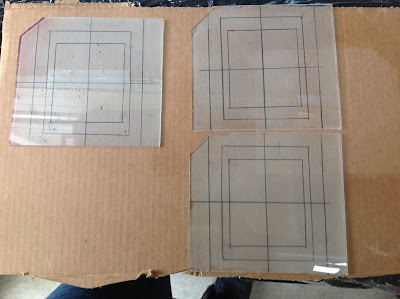I am always shooting in the field, and with that comes wind, rain, and sometimes just bad luck. Awhile back my camera hit the ground and sustained some injuries including the inside housing for the lens board and the ground glass cracked. Due to time constraints I did not have time to make a new ground glass, but today was the day! Went to Michael's and bought some of Ms. Martha Stewart's transluscent frost paint. I thought I could easily apply it with a brush WRONG! Luckily the paint easily washed off with a light scrubbing and soap. It took me several times to paint the frost on before I thought of another idea. I decided to add water to the paint, and then heat it up for 10 seconds in the microwave, (only 10 seconds! No more because it will cook the paint). When I had the paint and the water completely mixed I poured it on the clean ground glass plate just like collodion. I rocked the plate and had it flow evenly all over the ground glass, and for the couple of pin size air bubbles I had my razor blade to pop them. I drained the left over "emulsion" into a plastic cup and let the plate dry in the sun, (water evaporating), for about an hour and then I baked it for 30 minutes at 350 degrees Fahrenheit, turned off the oven and let the plates sit in the oven for another 30 minutes. It was really simple and could have been done in 20 minutes had I come up with the water and paint idea in the first place. Now I know and now have two perfect ground glasses.
Broken ground glass
Purchased the Frost paint at Michael's regular price $7.99, but had 40% coupon.
Glass from Home Depot around $8.00
The directions really did not clarify how to apply this stuff so I assumed a sponge would work
To save some glass I created a line using painters tape
Brushed on two coats and found it was to thick and I hated the lines it left
I left text under the glass to check to see how much "frost" I would get. The paint dried relatively fast and was hard to get rid of the brush strokes.
Comparing the old ground glass to the frosted paint stroke glass
Cut the glass in half, I probably should have done that first
I was getting frustrated with the lines so I started to cut out two ground glass pieces and just experiment from there
While still using the sponge I used the blue tape to prevent paint from getting on the back . I then went and washed off this paint and came up with the "flowing" idea.
Here is how the paint and water mixture looked. Notice 100% liquid, make sure there is no dust or contamination otherwise it will end up on your ground glass
Not to bad, let it dry in the sun and this is the even frost I got.
Into the oven
Out of the oven
Had to trace my plate sizes sixth, quarter, and half
Broken ground glass and the two brand new ones! Now I have a back up just in case Mother Nature throws my camera again
Before I installed the ground glass I used a matte fixative to make sure the pencil marks do not smear. This prevents the chemicals from removing the pencil marks, just a back up in case.
Installed and ready to go!






















Excellent, I've tried spray on and plastic sticky sheet for ground glass screens, never seen that liquid type before, gives a really good looking result. Nice one. A lot less messy than grinding with grit/water as I do.
ReplyDeleteKeep up the great work
Tony
Great result! I have a friend who is doing a decorative glass and I was thinking to ask him to do the ground glass, but your liquid works really cool!
ReplyDelete